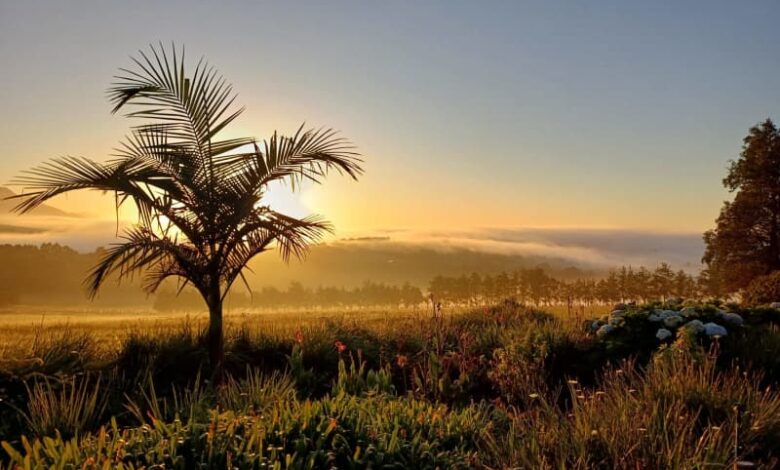Birders, South Africa’s Garden Route is a haven of avian diversity

Knysna is the crowning jewel of South Africa’s famous Garden Route, the coastal stretch known for its beaches, indigenous forests and charming towns.
Knysna is situated on a vast lagoon and won fame as the first oyster farming location in the country. People can buy the seafood from other regions of South Africa these days, but the sandy shoreline and coastal rainforests continue to draw people to the Garden Route.
People often forget that Knysna is also the namesake of three bird species. There’s the relatively small Knysna woodpecker adorned with a red cap, the shy and inconspicuous Knysna warbler and the splendid green Knysna turaco.
That is because the region is a bird paradise, with almost 450 species – more than half of South Africa’s native species – found along the Garden Route and in the Klein Karoo semi-desert in the hinterland.
A project by the bird conservation organization BirdLife South Africa aims to draw tourists to enjoy this biodiversity.
“If you’re a global birdwatcher, you have to come to South Africa at some point,” says guesthouse operator Tim Carr, himself an enthusiastic birder, as the country has many endemic species that only occur there.
According to BirdLife South Africa, there are 69, of which 50 are found in the Garden Route and Klein Karoo region.
“The diversity of bird species is absolutely extreme,” says Carr and invites us on a guided tour of his 80-hectare Reflections Eco-Reserve on the edge of the Garden Route National Park the next morning.
Carr, a stocky man wearing shorts despite the cool dawn, also works as a professional bird guide.
Bird guide excited
On his tour, he shares how he and his wife first felled the invasive pine trees in 2005, planted the first fast-growing native pioneer trees and then left the work to nature.
Because as soon as the birds find nesting opportunities again, they also bring the seeds of other natural tree species with them, Carr says.
The sun is just rising behind the Rondevlei lagoon lake, bathing the scenery in a golden light, though Carr does not waste a glance at it.
He suddenly falls silent, hearing the call of a Knysna woodpecker nearby – with a sound “like a rusty garden gate,” Carr says.
Within seconds, he switches from explanation mode to an almost feverish search mode, but to no avail.
But even if the bird doesn’t emerge, it is proof of how tourism serves nature conservation. Because if guests come to see the birds, their habitats are preserved. At least that’s the idea.
“The Knysna woodpecker lives in habitats that are coveted for the construction of golf courses and shopping centres,” says Carr, of the situation otherwise.
The birds need a lobby and BirdLife South Africa has compiled pages and pages of statistics to prove the economic value of travelling in the footsteps of Cape Rockjumpers, Cape Honeybirds and the like.
‘Bird-friendly’ accommodation
In 2023, the bird conservation organisation launched an initiative to promote birdwatching tourism and thus create jobs, a programme backed by the provincial government of the Western Cape. A website now provides an overview of birdwatching locations and “bird-friendly” accommodation. That means local guesthouse owners and guides have been trained in online courses to cater to the needs of birders.
One person who completed the course is Ethan le Fleur, 24. He was fresh out of Nelson Mandela University in nearby George when he started his job as a ranger and guide in the Gourikwa Nature Reserve in early 2023, with a diploma in nature conservation.
Le Fleur stands on a hill at the foot of which the surf of the Indian Ocean constantly crashes against the rocks, foaming white. A few hundred metres away, a small herd of zebras roams through the shrubbery.
When le Fleur began here, the area served as a conference centre and holiday home settlement. Few paid attention to the surrounding 2,000 hectares of wilderness. But that has changed. Today, le Fleur guides holidaymakers and school classes on “bird hunts” through the bush – though armed only with identification cards and binoculars.
“We have many different habitats here, so we also have many different birds,” he says. He has counted 120 species between the coast, wetlands and the fynbos landscape that characterises the Cape region.
Bird stalking for early birds
“Most children don’t even know the local bird species,” says le Fleur and admits that he felt the same way at first. A masked oriole that he kept hearing on campus eventually led him to investigate. That captured his interest – and he is determined to share it.
Christiaan Viljoen feels the same. He is curator of the Botanical Gardens in George, the largest town on the Garden Route and gets up early to take interested people birding before his actual work. “You want to do a bird tour at 6 am,” he says, as that’s when the birds are at their most active.
Those who follow him that early learn about the whole cycle of life. Visitors learn that the larvae of the Acraea horta butterfly feed on the leaves of the Kiggelaria africana tree species, which contain high levels of hydrocyanic acid, in order to store the poison inside and fend off most predators.
The exceptions are cuckoo species such as the golden cuckoo, the emerald cuckoo and the Klaas cuckoo: they can digest the larvae and so are frequently found in the trees.
“You can’t just plant three or four tree species, you have to reintroduce all of them,” says Viljoen – then the birds will also return. He is on the way to achieving this in his botanical garden.
And throughout the Garden Route, the message has arrived as more reserves opt for renaturalization – for the benefit of birds and delight of birdwatchers.

Don’t forget your binoculars! Birdwatching on the Swartberg Pass in the Western Cape province. Christian Selz/dpa

Cliff oystercatchers on the beach at Nature’s Valley. Christian Selz/dpa

The paradise crane is the national bird of South Africa. With a bit of luck, it can also be spotted on the Garden Route. Christian Selz/dpa

Reed cormorants are among the birds that can be spotted in the Garden Route National Park. Christian Selz/dpa

A summer visitor from Europe, this common buzzard was spotted on a fence near Mosselbay. Christian Selz/dpa
https://media.zenfs.com/en/dpa_international_526/1bc4b52b9951ffdc6c42b87a5c3ffc99
2025-02-10 14:46:35




